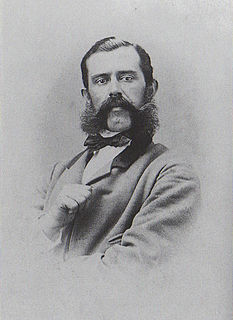
Karl Hermann Johannes Thiele was a German zoologist specialized in malacology. Thiele was born in Goldap, East Prussia. His Handbuch der systematischen Weichtierkunde is a standard work. From 1904 until his retirement in 1925 he was the curator of the malacological collection at the Museum für Naturkunde in Berlin. Thiele described more than 1.500 new species of molluscs; until today their types are deposited with the Museum of Natural History in Berlin. Especially important are his works on the Mollusca of the First German Antarctica Expedition and of the German Deep Sea Expedition aboard the vessel Valdivia.

Friedrich Hermann Loew was a German entomologist who specialised in the study of Diptera, an order of insects including flies, mosquitoes, gnats and midges. He described many world species and was the first specialist to work on the Diptera of the United States.

Othmar Reiser or Otmar Rajzer was an Austro-Slovenian ornithologist and naturalist who worked as curator of the bird collections in the natural history museum at Sarajevo, working there from its foundation for thirty-three years during which he explored various regions including the Balkans and South America and collecting specimens for the museum. Several species are named after him based on his specimens.

Eduard von Martens also known as Carl or Karl Eduard von Martens, was a German zoologist.

Felix Philipp Kanitz was an Austro-Hungarian naturalist, geographer, ethnographer, archaeologist, painter and author of travel notes, of Jewish heritage.

Georg Ritter von Frauenfeld was an Austrian naturalist and one of the leading scientists on board the Austrian frigate Novara during its round-the-world voyage. He was heavily involved in the development of the Naturhistorisches Museum in Vienna, where he was a curator.

August Friedrich Thienemann was a German limnologist, zoologist and ecologist. He was an associate Professor of Hydrobiology at the University of Kiel, and director of the former Hydrobiologische Anstalt der Kaiser-Wilhelm-Gesellschaft at Plön.
Everniopsis is a fungal genus in the family Parmeliaceae. It consists of a single species, the bark-dwelling lichen Everniopsis trulla, which occurs in Africa and South America.
Stefan Clessin was a German malacologist.

Moritz Allé (1837-1913) was an Austrian astronomer and mathematician, one of the teachers of Nikola Tesla.

Ernst Stizenberger was a German physician and lichenologist.
Max Saalmüller was a Prussian lieutenant colonel and German entomologist.
Tall Munbāqa or Mumbaqat, the site of the Late Bronze Age city of Ekalte, is a 5,000-year-old town complex in northern Syria now lying in ruins. The ruins are located on a steep slope on the east bank of the upper course of the Euphrates. In the 3rd and 2nd millennium BC the city was an important city-state in the region. Due to the establishment of the Tabqa Dam at Al-Thawrah, 35 kilometers west of Raqqa, the city ruins are partially flooded today by Lake Assad. Situated high above the steep drop of the eastern shore, Tall Munbāqa is still preserved.
The Ohlsbach Formation is a geologic formation in Germany. It preserves fossils dating back to the Gzhelian stage of the Late Carboniferous period.
Balzer Peter Vahl was burgomaster of Greifswald. He founded the Greifswald merchant family Wahl
Leonhard Schultze-Jena was a German explorer, zoologist, and anthropologist known for his explorations of German Southwest Africa and New Guinea, as well as for his studies on Mesoamerican languages.

The Wildhornhütte is a refuge of the Swiss Alpine Club (SAC) and is located on the Wildhorn massif in the western Bernese Alps. The hut is managed by the SAC Moléson section.

Opegraphaceae is a family of lichen-forming and lichenicolous fungi in the order Arthoniales. It was originally proposed by German lichenologist Ernst Stizenberger in 1862. It fell into disuse, but was resurrected in a molecular phylogenetic study of the order Arthoniales published in 2010. It now includes taxa that were previously referred to the family Roccellaceae, its sister group.
Geophilus pusillus is a species of soil centipede in the family Geophilidae found in Algeria. It grows up to 11 millimeters in length. Records from the Alpstein mountains indicate that G. pusillus is a soil-dwelling species that prefers humus-rich soil, but these records deserve confirmation.
Wilhelm Duschinsky was an Austrian philologist, educator, and writer.










